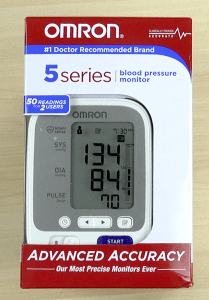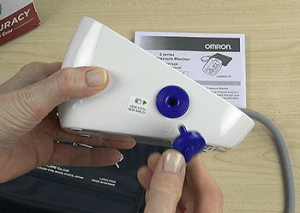At a recent doctor’s appointment, the nurse noted that my blood pressure was lower than it should have been. As a result, the doctor recommended that I start blood pressure monitoring at home. So I purchased the Omron 5 Series Blood Pressure Monitor (view on Amazon), which measures blood pressure and heart rate (pulse).
My doctor’s recommendation prompted me to wonder if other older adults might want to monitor their blood pressure at home. After all, blood pressure and pulse seem to be the first things the nurse checks at my doctors’ appointments.
Is Blood Pressure Monitoring at Home a Good Idea?
I checked the website of my favorite online geriatrician Dr. Leslie Kernisan, Better Health While Aging, to find out her thoughts about measuring our own blood pressure.
Turns out, Dr. Kernisan believes blood pressure monitoring at home is a good idea for older adults. Older adults can monitor their blood pressure at home for a variety of reasons, including to help prevent falls, to monitor new medications or changes in medications, and to get help more quickly by having this vital information on hand when calling a health professional.
Caution: Home monitoring of blood pressure is not a substitute for regular visits to your physician!
VIDEO: Blood Pressure Monitoring at Home
How Does a Home Blood Pressure Monitor Help Avoid Falls?
Older people can experience a drop in blood pressure when standing up from a seated or lying position, explains Dr. Kernisan. Often called orthostatic hypotension, this drop in blood pressure can cause lightheadedness, which could potentially cause an older person to fall. Home blood pressure monitoring can alert us of this fall risk factor, so we can discuss it with our health professionals. Many times this can be corrected by adjusting blood pressure medications, Dr Kernisan notes.
I hadn’t thought about this, but it makes a lot of sense. And anything that can reduce our risk of falls as we get older is important, considering the many older adults affected by falls every year.
Does Home Blood Pressure Monitoring Help With Blood Pressure Medication?
Since many older adults are on blood pressure-lowering medication, home blood pressure monitoring can help check the effects of new medications or changes in current medication, according to Dr. Kernisan.
Monitoring at home can speed up the process to find the right dosage more quickly, she says. We can know more quickly how a medication may be affecting our blood pressure and heart rate without having to wait for our next scheduled appointment.
Can Home Blood Pressure Monitoring Help Our Doctors?
Dr. Kernisan notes that we can help our health professionals help us more quickly when we call them if we are able to tell them our blood pressure and heart rate, along with any symptoms we are experiencing. The medical professionals can then assess and determine the best course of action more quickly than if we waited for our regularly scheduled, in-office appointment to have our readings taken.
With our vital information in hand, we can call our doctor’s office so they can tell us how to proceed, or if we should come in right away to be checked in person.
For more information from Dr. Kernisan about home blood pressure monitoring visit Choosing & Using a Home Blood Pressure Monitor, & What to Ask the Doctor.
Note: If you prefer to listen, you can access Dr. Kernisan’s podcast about home blood pressure monitoring here: 3 Reasons You Should Have a Home Blood Pressure Monitor. (Listen to more of Dr. Kernisan’s podcasts on Aging.)
Can You Take Your Own Blood Pressure Measurement?
 Omron 5 Series Blood Pressure Monitor
Omron 5 Series Blood Pressure Monitor
I wasn’t sure if I could take my own blood pressure but the Omron 5 Series is easy to use and has big readable numbers on the screen. I followed the directions on the Quick Start Guide and referred to the included fold-out manual. Once I read through the literature and set up the Omron machine (easy), I had my “vitals” measured pretty quickly.
The monitor comes in two parts: the unit itself and the cuff that wraps around your arm. Batteries come included so it was just a matter of inserting the 4 “AA” batteries and attaching the cuff to the unit.

To attach the cuff to the unit, I inserted the Air Tube Plug into the Air Tube Jack on the side of the unit. The unit can take measurements at this point, but the Quick Start Guide shows us how to set the Date and Time. This is important because the Omron 5 Series stores the last 50 measurements in memory. To correctly record when those measurements were taken, the date and time need to be set before measuring.
Note: To view the stored measurements, press the button with the pencil and paper icon (on the lower right front of the machine) and use the arrow buttons to scroll through the results.
Preparing to Measure
The included literature cautions that we should avoid bathing, drinking, smoking, exercising, and eating for 30 minutes prior to taking the measurement, and rest for 15 minutes before taking the measurement. It also advises to sit quietly at a table and rest the arm so that the cuff is at the same level as the heart. According to the included manual, we should be sitting with our feet on the floor and our back straight.
Measuring With the Omron 5 Series
Once I got the Date and Time Set, I was ready to measure. I loosened the D-Ring cuff and slid it up over my left upper arm, one-quarter inch above my elbow and with the tubing aligned with my middle finger (palm facing upward), as advised in the manual. Then I pulled the end of the cuff snug (not tight) and secured the velcro closure. The cuff, according to Omron, should fit standard and large adult arms with circumferences from 9 inches to 17 inches (22 cm to 42 cm).
I selected my User ID, which is either 1 or 2. It comes set to 1, so I left it at that setting. If another person also will measure using the same machine, make sure to change it back to the correct ID before measuring.
I pressed the Start/Stop button and let the machine do the work. The cuff inflated and took less than a minute until the Blood Pressure and Heart Rate displayed on the screen.
How to Measure Without Storing Measurements
The Omron can measure and store the last 50 readings for up to two people. If you want to measure without storing, you can use the Guest mode: Hold the Start/Stop button for more than three seconds until the User Icons at the top screen disappear. The cuff will inflate and the measurements will be taken without storing in memory.
Omron Wireless Options
I keep a paper record of my measurements, but there are other Omron Blood Pressure Monitors like the Omron 7 Series Wireless and the Omron 10 Series Wireless that wirelessly connect to the Omron Connect app for select iPhones, Android, and Amazon Alexa-enabled devices. The wireless connectivity may be more convenient for some users. Check compatibility of your phone and operating system with Omron’s Compatible Devices & Operating Systems.
Always Keep Your Doctors’ Appointments
There is no substitute for an in-person visit to your healthcare professional. But the more we know about our own health, the more prepared we are to help our medical professionals to help us. Always discuss specific directions with your medical professionals before using a blood pressure monitor or any home medical device, and always discuss your results with your health professionals.
Additional Information on Home Blood Pressure Monitoring
From the Mayo Clinic:
From the American Heart Association:


This is very informative! I have high blood pressure and actually use this very same monitor. Very easy to use. I think everone should have a blood pressure m onitor and that insurances would cover them. It enables us to keep a check on heart rate and pulse also. Thanks for posting this article..so much I still want to read about.
Hi Sandra! Yes, it is easy to use isn’t it! I was impressed with how easy it is to measure such important information right at home. And you have a great idea about insurance companies providing these blood pressure monitors! I hope they read this; it might actually save them money in the long run!
Thanks for commenting!